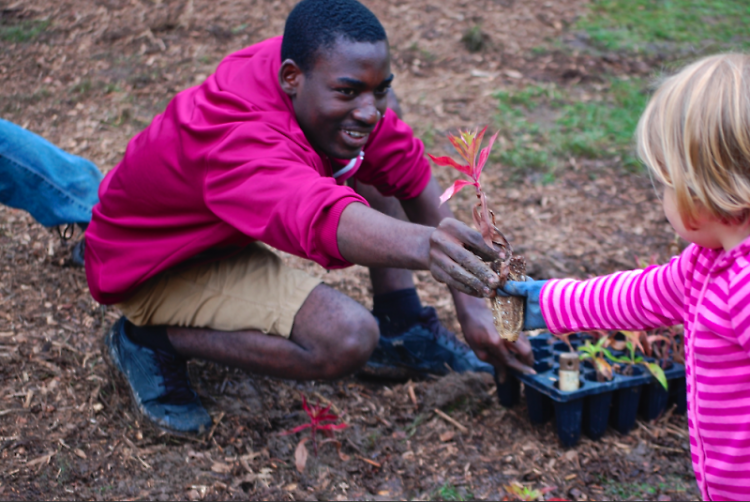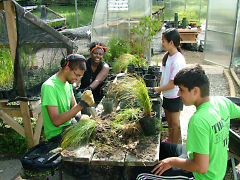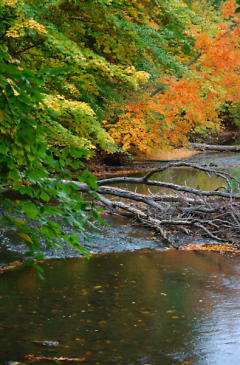Written by Gail Gunst Heffner (with David Warners and Michael Ryskamp)
Lake Michigan is an important contributor to the health of the Great Lakes region, the largest fresh water resource in the world. The Grand River and its many tributaries are critical to the survival of Lake Michigan. One of the tributaries that drains into the Grand River is Plaster Creek, now recognized as the most damaged creek in West Michigan. As an urban stream, Plaster Creek faces many of the problems commonplace for urban waterways throughout the United States. It suffers from high levels of bacterial contamination, excess sedimentation caused by erosion, nutrient pollution from lawn fertilizers and flooding caused by stormwater run-off. Plaster Creek originates near Caledonia, flowing north for 14 miles through agricultural, commercial, industrial, suburban and urban neighborhoods. The 58-square mile Plaster Creek watershed is an integrator, connecting farmers, businesses, schools, churches and residents, to issues of common concern within a shared place. What happens in the Plaster Creek watershed has far reaching effects.
A bit of history of the Plaster Creek watershed
By the time the first European explorer Samuel de Champlain reached West Michigan in 1615, the Plaster Creek watershed was occupied and used by the Odaawaa Indians (today known as the Ottawa) and they called this stream Kee-No-Shay, which means "water of the walleye." In the early 1800s a Native American leader, Chief Blackbird, coerced a missionary into a small boat and the two of them floated down Plaster Creek until they reached a beautiful waterfall pouring over a large, colorful and crystalline outcrop of gypsum. This was the first known encounter of European immigrants with gypsum in West Michigan, a rock that was subsequently mined throughout the Grand Rapids area. Ground up gypsum was used as both a fertilizer and as a base for making plaster. In fact the first plaster mill in West Michigan was set up in 1841 near that sacred spot among the Ottawa, and ever since then, the creek was known as Plaster Creek.
As the city of Grand Rapids developed and expanded, the quality of Plaster Creek progressively declined. Walleye and brook trout were lost by the early 1900s, and several of the creek’s tributaries were relegated to underground pipes, including a four mile stretch of Burr Oak Creek, today known as Silver Creek, one of Plaster Creek’s two major feeder streams. By the early 2000s the creek had become so degraded that it had earned the distinction as West Michigan’s most polluted stream, often carrying bacterial loads so high as to be designated unsafe for even partial human body contact.
The long journey to restore Plaster Creek
In 2004, faculty at Calvin College began service-learning projects for students, collecting data on the state of the watershed and organizing stream clean-ups in collaboration with other community partners. By 2008 a group of concerned organizations, including Calvin College, began meeting regularly to discuss steps that could be taken to improve the watershed. A staff member of the Michigan Department of Environmental Quality approached Calvin specifically for help to reach the faith community in West Michigan. Calvin responded by organizing a three-day summer workshop for local churches focusing on a theological foundation for creation care, the basics of watershed ecology and practical strategies for watershed restoration. From this first summer workshop, Plaster Creek Stewards was launched.
Three focus areas: education and outreach, research, and on-the-ground restoration
Educating the public is a key aspect of the mission of Plaster Creek Stewards. We have focused on educating local schools, churches, businesses and neighborhood associations. With each educational event, we also provide an opportunity for people to take action to restore the watershed. A particular emphasis has been on creating upstream-downstream partnerships within the watershed. Very few Americans think about the relationships between those upstream with those downstream, so working to form intentional partnerships between upstream schools and churches with downstream schools and churches has been one of the focal points of our work. This requires a long term commitment because building relationships of trust between rural and urban groups does not happen overnight.
Since Plaster Creek Stewards emerged out of Calvin College, research has been a natural focus. With increased emphasis on undergraduate research experience nationally, Calvin redesigned its biology core curriculum in 2011 to include a Sophomore level Research Methods course, a class that uses the Plaster Creek Watershed as its living laboratory. Student projects are summarized in a written scientific paper and presented in a public forum. In addition to biological research, we have also started a social research oral history project, collecting stories and memories from people who have lived, worked, gone to school or church within the Plaster Creek watershed over the past 60 years and this has been a great way to engage the public in caring for the watershed.
A third focus of Plaster Creek Stewards is on-the-ground restoration. We use greenhouses owned by the college to grow native plants from seed, all of which is collected from natural areas around Grand Rapids. We use the plants in green infrastructure community-based projects to install rain gardens and native habitat gardens, mostly in urban and suburban areas. With their long root systems, these native plants soak up and filter stormwater. This past year we grew over 35,000 plants that were installed in watershed restoration projects. As the benefits of green infrastructure become more commonly known, more and more people are asking us to install rain gardens and other types of native plantings on their personal property. There is growing interest in promoting the biological benefits of green infrastructure and native habitat plantings as one way to restore water quality in our urban waterways.
It has taken Plaster Creek over 100 years to achieve the degraded condition it is in today and it will require several decades to restore it, but we are seeing growing interest among West Michigan residents to learn what they can do to care for their particular place. As momentum continues to build we are cultivating the hope that one day the walleye will return, and the creek’s name can be changed back to Kee-No-Shay. For more information or to get involved in watershed restoration, visit the Plaster Creek Stewards page on the Calvin website.
The Rapidian, a program of the 501(c)3 nonprofit Community Media Center, relies on the community’s support to help cover the cost of training reporters and publishing content.
We need your help.
If each of our readers and content creators who values this community platform help support its creation and maintenance, The Rapidian can continue to educate and facilitate a conversation around issues for years to come.
Please support The Rapidian and make a contribution today.



